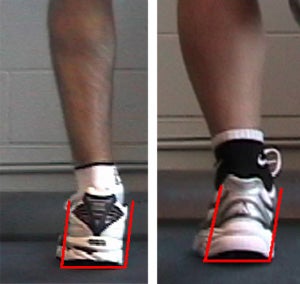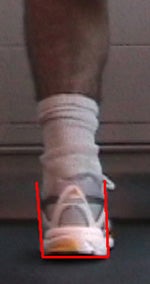Left Foot Displaying a Moderate Level of Over-Pronation
See All Support Running ShoesLEARNING CENTER: HOW TO
HOW TO DETERMINE PRONATION
Often misunderstood, pronation is considered by many to be a negative attribute; pronation is actually a good thing in the correct amount. Pronation is the body's response to the ground forces incurred during running and walking. When the foot impacts the ground, the arch elongates and flattens, which allows the foot to roll inward. This action helps the body to absorb shock. The degree to which the arch flattens is often associated with the degree the foot pronates. An ideal foot-strike is said to be neutral and is characterized by slight inward movement of the ankle-bone during stance (when the foot is in contact with the ground).
- 20-30% of runners have neutral pronation and are best suited for neutral running shoes. They can also have success wearing mild support shoes.
While a slight amount of pronation is the proper means to absorb shock naturally, too much pronation (over-pronation) can potentially contribute to many maladies, which can sideline a runner. A foot that pronates excessively is one that continues to roll inward past a neutral position after the shock of impact has been absorbed. Uncorrected and repeated, this motion may lead to repetitive stress related injuries of the feet and legs. More times than not, the runner who over-pronates needs a shoe that reduces excess pronation and guides the foot along a neutral path.
- Most runners exhibit over-pronation in varying degrees.
- 50-60% of runners exhibit mild to moderate over-pronation and are best suited for support running shoes.
- 20-30% of runners exhibit severe over-pronation and are best suited for motion control shoes.
On the opposite extreme, not enough pronation (supination or under-pronation) results in the body being less able to absorb shock and may result in a different set of maladies. A foot that supinates (under-pronates) actually has an arch that fails to elongate and the foot motion tends not to absorb the shock of impact; instead, the impact stress of each foot-strike is transferred through the joints, bones and tendons of the foot and lower legs. For the runner that supinates the most important shoe aspects are cushioning and flexibility.
- Roughly 3% of runners supinate (under-pronate). These runners are best suited for neutral running shoes.
Fortunately, modern running shoes are designed to help provide varying levels of support cushioning and flexibility to address a particular runner's needs based on degree of pronation.

Left Foot Displaying a Moderate Level of Over-Pronation
The Same Runner's Left Foot Being Corrected into a Neutral Position by a Moderate Support Shoe
For further information, please refer to the Learning Center and read Foot Analysis, Shoes 101 and Selecting A Shoe.




